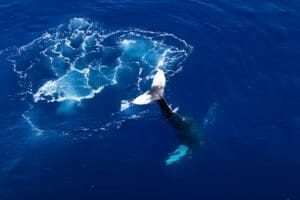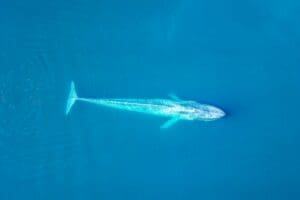Secrets of the Baird’s Beaked Whale
Dive deep into the enigmatic life of one of the ocean’s most elusive creatures, known for their remarkable deep-diving abilities and unique appearance – Baird’s Beaked Whale.
These whales are super swimmers, diving deep into the ocean, and they have some pretty cool features that make them special.
We’re going to explore all the cool stuff about these whales, from their incredible diving skills to their unique looks.
Facts First


Understanding Baird’s Beaked Whale
Scientific name and classification
You might not be familiar with Baird’s Beaked Whale, a unique marine mammal named after the American naturalist Spencer Fullerton Baird. Its scientific name, Berardius bairdii, places it within the Ziphiidae family, also known as the beaked whales. This family is known for their distinct elongated beaks, and the Baird’s Beaked Whale is no exception.
Physical characteristics and appearance
Observing Baird’s Beaked Whale, you’d notice its sizable body, which can reach up to 42 feet (approximately 12.8 meters) in length, making it one of the largest members of the beaked whale family. Visualize a long, robust body with a small dorsal fin set far back. Their coloration might intrigue you, as they usually have a dark gray or brown color with potential scars from skirmishes with other marine animals or parasites.
Geographical distribution
Should you wish to spot one of these creatures, you’d need to head to the cooler waters of the North Pacific Ocean. Their range extends from Japan and the Kamchatka Peninsula all the way to the Bering Sea and the Aleutian Islands. They seem to prefer deep oceanic waters, making them relatively difficult for the casual observer to spot.
Anatomy and Physiology
Unique skeletal structure
Your fascination with the anatomy of the Baird’s Beaked Whale might grow when you learn about its unique skeletal structure. Unlike other whales, they possess many vertebrae in their back, supporting their elongated body. Their skull is specially adapted to withstand the immense pressures of the deep sea.
Adaptations for deep diving
Imagine diving into the ocean’s depths without any gear — it seems impossible, right? But for Baird’s Beaked Whales, deep diving is a part of life. They have adaptations like large spleens and high levels of myoglobin, allowing them to store more oxygen and endure prolonged periods underwater. They can dive for nearly an hour and reach depths of over 3,000 feet (approximately 914 meters).
Thermoregulation in cold water environments
Your body would shiver in the frigid deep-sea environments these whales inhabit, but they have a thick layer of blubber to insulate themselves. Moreover, their circulatory system adjusts blood flow to vital organs to maintain core body temperature. Quite the natural marvel, don’t you think?
Behavioral Patterns
Social structure and group dynamics
When you visualize the social life of Baird’s Beaked Whales, you will picture small pods consisting of 5 to 20 individuals. These whales are known to form tight-knit groups, which may consist of families staying together. Such social structures aid in cooperative hunting and protection against predators.
Migration and movement patterns
You wouldn’t say that Baird’s Beaked Whales are homebodies. They are known for their elusive migration patterns, which are not well-understood. It’s believed that they move in response to the availability of prey and seasonal changes, but tracking their precise movements has been challenging for researchers.
Feeding habits and prey selection
Dive into the feeding habits of these magnificent creatures, and you’ll discover a diet primarily consisting of deep-sea fish and cephalopods like squid. Their pointed beaks are ideal for snatching such slippery prey. They may also occasionally feed on crustaceans, showing a diverse palate adapted to deep-sea dining.
Vocalization and Communication
Types of sounds produced
Your ears might perk up upon hearing the clicks, calls, and whistles produced by Baird’s Beaked Whales. These sounds are essential for echolocation — a sonar system that helps them navigate murky waters and locate food with precision.
Purpose of vocalizations
Baird’s Beaked Whales rely on vocalizations not only for foraging but also for communication with one another. Through these sounds, they convey messages, coordinate during hunts, and maintain social bonds.
Differences from other whale species
What makes Baird’s Beaked Whales’ vocalizations unique compared to other whales? Their frequency ranges and patterns differ significantly. These distinctive sounds are integral to their deep-sea lifestyle, exemplifying how adaptations can be as much about sound as physiology.
Reproduction and Lifespan
Breeding behaviors
In the world of Baird’s Beaked Whales, courtship and reproduction are kept largely out of human sight. However, it’s known that they exhibit complex mating rituals and strategies to ensure the propagation of their species.
Gestation period and birth
Imagine carrying a calf for more than a year — that’s a reality for female Baird’s Beaked Whales. Their gestation period lasts around 17 months, after which they give birth to a single calf that they’ll nurse for quite some time to prepare it for the autonomous life in the open ocean.
Lifespan and aging process
Your life span may seem lengthy, but Baird’s Beaked Whales can live even longer. They are among the longest-lived whale species, with lifespans reaching up to 80 years. This extended life cycle contributes to the depth of knowledge passed down through generations within their pods.
Dietary Habits
Preferred prey and hunting strategies
When mealtimes come, Baird’s Beaked Whales showcase impressive hunting strategies. They often dive deep to surprise squids and fish, swallowing their prey whole with their toothless jaws. Visual predation may play a role during the final moments of the hunt, adding an element of stealth to their skill set.
Seasonal changes in diet
Your taste in food might change with the seasons, and the same goes for these whales. They adapt their diet based on the seasonal availability of certain prey, showcasing a remarkable ability to adjust to the ocean’s rhythms.
Role in the marine food web
Recognizing their place in the marine food web, you’d see Baird’s Beaked Whales as apex predators in their realm. Their feeding habits impact the populations of deep-sea fish and squids, thus maintaining ecological balance in their environment.
Conservation Status and Threats
Current conservation status
As you look into their conservation status, you’ll learn that Baird’s Beaked Whales are classified as “Data Deficient” by the IUCN Red List. This indicates that there isn’t enough information to assess their global population and conservation needs properly.
Natural and human-induced threats
Various threats loom over these whales, ranging from natural predators like killer whales to human-induced risks, including entanglement in fishing gear, marine pollution, and the impact of noise pollution on their sensitive hearing and communication.
Efforts for protection and conservation
On a hopeful note, conservation efforts are being made to understand and protect Baird’s Beaked Whales better. Marine protected areas, legal protections, and initiatives to reduce ocean noise and pollution are all part of these endeavors.
Research and Observation
Methods for studying Baird’s beaked whales
If you set out to study Baird’s Beaked Whales, you’d likely employ methods like acoustic monitoring, satellite tagging, and photographic identification. These techniques provide insights into their behavior, distribution, and overall health.
Challenges in research
One can’t overlook the challenges in researching these elusive creatures. Their deep-diving behavior and preference for remote areas make them hard to observe and study consistently, resulting in gaps in our understanding of their way of life.
Recent discoveries and findings
Despite the obstacles, recent discoveries have shed light on their lifestyle and adaptations. Each piece of new information enriches the scientific narrative of Baird’s Beaked Whales and informs conservation strategies.
Cultural Significance and Human Interactions
Historical significance in native cultures
To indigenous cultures around the North Pacific, Baird’s Beaked Whales have historically been revered creatures. Their significance is woven into folklore and traditions, reflecting a profound respect and kinship with these sea giants.
Contemporary interactions and whale watching
In the present day, you might engage with Baird’s Beaked Whales through regulated whale watching, a practice that allows for respectful and non-invasive observation. It’s a unique opportunity to connect with these mysterious beings.
Impact of human activities on populations
Your everyday actions have ripples that reach even the depths where Baird’s Beaked Whales roam. Pollution, overfishing, and climate change induced by human activity all contribute to these whales’ challenges in their natural habitats, emphasizing the need for mindful coexistence.
Advancements in Baird’s Beaked Whale Study
Innovations in tracking and monitoring
The adoption of new technologies has revolutionized the study of Baird’s Beaked Whales. Innovative tracking devices and monitoring techniques provide unprecedented insights into their secretive lives.
Genetic studies and population health
Genetic studies are unraveling the mysteries of Baird’s Beaked Whale populations, aiding in assessing their genetic diversity and health. Such information is critical for effective conservation measures.
Collaborations and international research efforts
International collaboration is key to safeguarding the future of Baird’s Beaked Whales. Researchers across the globe are joining forces, pooling knowledge and resources to ensure these fascinating creatures continue to thrive for generations to come.








